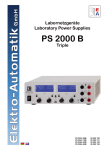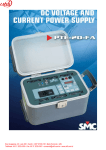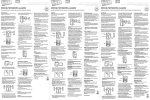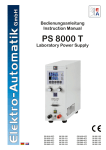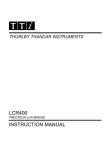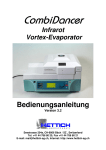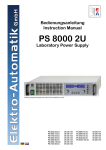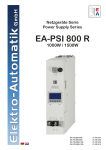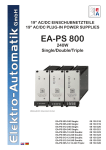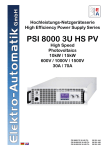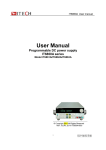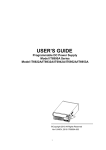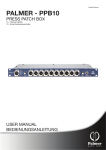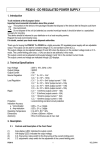Download DE - Electrocomponents
Transcript
Bedienungsanleitung Instruction Manual PS 2000 B Laboratory Power Supply PS 2042-06B: PS 2042-10B: PS 2042-20B: PS 2084-03B: PS 2084-05B: PS 2084-10B: 39 200 112 39 200 113 39 200 114 39 200 116 39 200 117 39 200 118 DE Allgemeines Impressum Elektro-Automatik GmbH & Co. KG Sicherheitshinweise Helmholtzstrasse 31-33 41747 Viersen Germany Telefon: 02162 / 37850 Fax: 02162 / 16230 Web: www.elektroautomatik.de Mail: [email protected] © Elektro-Automatik Nachdruck, Vervielfältigung oder auszugsweise, zweckentfremdete Verwendung dieser Bedienungsanleitung sind verboten und können bei Nichtbeachtung rechtliche Schritte nach sich ziehen. Seite 1. Einleitung................................................................. 4 2. Installation................................................................ 4 2.1 Netzanschluß...................................................... 4 2.2 Lasten anschließen............................................. 4 3. Ansichten................................................................. 4 3.1 Bedien- und Anschlußelemente.......................... 4 4. Bedienung................................................................ 6 • Das Gerät ist nur mit der angegebenen Netzspannung zu betreiben! • Keine mechanischen Teile, insbesondere aus Metall, durch die Lüftungsschlitze in das Gerät einführen! • Die Verwendung von Flüssigkeiten aller Art in der Nähe des Gerätes ist zu vermeiden, diese könnten in das Gerät gelangen! • Keine Spannungsquellen an den Ausgang des Gerätes anschließen, die die Nennspannung des Gerätes übersteigen können! • Keine Spannungsquellen mit umgekehrter Polarität an den Ausgang des Gerätes anschließen! • Nach dem Ausschalten des Ausganges bzw. des Gerätes kann am Ausgang noch berührungsgefährliche Spannung anliegen, zumindest für eine gewisse Zeit. • Achtung! Die Gehäuseunterseite erwärmt sich bei längerem Betrieb mit hoher Last. ........................................................ 6 4.1 Anzeige 4.1.1 Abkürzungen in der Anzeige.......................... 6 4.1.2 Fehlermeldungen........................................... 6 4.2 Tasten.................................................................. 6 4.2.1 Taste Preset ............................................ 6 . .......................................... 6 4.2.2 Taste On/Off 4.3 Weitere Bedienelemente..................................... 6 4.4 Sollwerte einstellen............................................. 6 4.4.1 Feineinstellung............................................... 7 4.4.2 Einstellschrittweiten....................................... 7 4.5 Bedienfeldsperre (LOCK).................................... 7 5. Verhalten.................................................................. 7 5.1 Einschalten mit dem Netzschalter....................... 7 5.2 Überspannung..................................................... 7 5.3 Überhitzung......................................................... 7 5.4 Überstrom........................................................... 8 6. Hilfe bei Problemen.................................................. 8 6.1 Hardware-Probleme............................................ 8 6.2 Software-Probleme............................................. 8 7. Weitere Anwendungen............................................. 8 7.1 Reihenschaltung................................................. 8 7.2 Parallelschaltung................................................. 8 7.3 Fernsteuerung mit EasyPS2000......................... 9 7.4 Programmierung................................................. 9 7.5 Firmwareaktualisierung....................................... 9 8. Technische Daten................................................... 10 8.1 42V-Modelle...................................................... 10 8.2 84V-Modelle.......................................................11 Bedienungsanleitung PS 2000 B Single Serie Stand: 18.04.2013 3 DE Über das Gerät 1. Einleitung Die Labornetzgeräte der Serie PS 2000B sind sehr kompakte und robuste Geräte, die auf kleinem Raum eine Vielzahl von interessanten Möglichkeiten bieten. Die Geräte eignen sich aufgrund des berührungsfreien Aufbaus und der einfachen Handhabung besonders für den Einsatz in Schule, Ausbildung, Werkstatt oder Labor. Es sind drei Leistungsklassen mit 100W, 160W oder 320W verfügbar. 3. Ansichten 3.1 Bedien- und Anschlußelemente Netzschalter Dient zum Einschalten oder Ausschalten des Gerätes. Taster „Preset“ Dient zur Umschaltung der Anzeige auf die Sollwerte. Weiterhin wird mit der Taste die Bedienfeldsperre aktiviert. Siehe Abschnitte 4.4 und 4.5. Über die gängigen Funktionen von Netzgeräten hinaus können zum Beispiel die Tasten und Einsteller gegen ungewollte Veränderung der Sollwerte gesperrt oder eine Abschaltung des Ausgangs bei Überschreiten einer einstellbaren Spannungs- bzw. Stromschwelle erreicht werden. Anzeige Weiterhin ist eine fest integrierte USB-Schnittstelle vorhanden, die es ermöglicht, das Gerät mittels eines PCs und einer Software fernzusteuern und zu überwachen. Einsteller „Voltage“ 2. Installation Mini-USB-Buchse 2.1 Netzanschluß Dient zum Anschluß des Gerätes an einen PC. Siehe auch Abschnitt 7.3. Das Gerät wird über das beiliegende Netzanschlußkabel angeschlossen und geerdet. Deshalb darf das Gerät nur an einer Schutzkontaktsteckdose betrieben werden. Diese Maßnahme darf nicht durch Verwendung einer Anschlussleitung ohne Schutzleiter unwirksam gemacht werden. Diese blaue LCD-Anzeige bietet alle wichtigen Informationen auf einen Blick. Dient zum Einstellen der Ausgangsspannung oder der Überspannungsschwelle OVP. Einsteller „Current“ Dient zur Einstellung des Stromes oder der Überstromschwelle OCP. Die Absicherung des Gerätes erfolgt über eine 5 x 20mm Schmelzsicherung, die sich in der Netzbuchse in einer Schublade befindet. Wert siehe Typenschild oder Sicherungsaufdruck. Taster „On/Off“ 2.2 Lasten anschließen Leistungsausgang, gepolt, Sicherheitsbuchsen Der Lastausgang befindet sich auf der Vorderseite des Gerätes. Der Ausgang ist nicht über eine Sicherung abgesichert. Um Beschädigungen des Verbrauchers zu vermeiden, sind die für den Verbraucher zulässigen Nennwerte stets zu beachten. Dient zum Einschalten oder Ausschalten des Ausganges. Die Buchsen können zum Einstecken von 4mm Büschelsteckern (offen oder geschlossen) verwendet werden. Die Buchse zwischen den beiden DC-Ausgangsbuchsen ist mit dem Schutzleiter der Netzzuleitung verbunden und kann zur Erdung eines angeschlossenen Verbrauchers genutzt werden. Temperaturgeregelter Lüfter Nur bei 320W-Modellen vorhanden. Luftaustritt nach hinten. Um ausreichende Belüftung zu gewährleisten, ist hinter dem Gerät möglichst viel Platz, jedoch mindestens 10cm freizulassen. Der Lüfter kann bei starker Erwärmung des Gerätes hohe Drehzahlen erreichen und somit eine gewisse Geräuschbelastung erreichen. 4 Stand: 18.04.2013 Bedienungsanleitung PS 2000 B Single Serie DE Über das Gerät Bild 1 Bild 2a. Rückansicht 100W / 160W Bild 2b. Rückansicht 320W Bedienungsanleitung PS 2000 B Single Serie Stand: 18.04.2013 5 DE Über das Gerät 4. Bedienung 4.2.2 Taste On/Off Diese Taste dient zum manuellen Ein- oder Ausschalten des Ausganges, sofern sich das Gerät nicht im Fernsteuerungsbetrieb befindet. 4.1 Anzeige Der Zustand des Ausganges wird mit dem Statustext (ein) oder (aus) in der Anzeige angezeigt. Die Taste kann durch den Zustand LOCK blockiert sein. Siehe auch „4.5 Bedienfeldsperre (LOCK)“. Weiterhin quittiert die Taste Fehler, die durch den Status „Error“ gemeldet werden. Siehe auch Abschnitt 4.1.2. Bild 3 4.1.1 Abkürzungen in der Anzeige Die Kürzel in der Anzeige stellen den Status dar und bedeuten folgendes: CV - Spannungsregelung aktiv (nur bei Ausgang „ein“) CC - Strombegrenzung aktiv (nur bei Ausgang „ein“) Preset V/C - Sollwertanzeige Spannung/Strom aktiv 4.3 Weitere Bedienelemente Einsteller Voltage & Current Die Einsteller dienen zum Einstellen diverser Werte am Gerät. Zuweisung: • Links - Spannung (U) oder OVP, abhängig vom Modus • Rechts - Strom (I) oder OCP, abhängig vom Modus Preset OVP/OCP - Sollwertanzeige OVP/OCP aktiv Näheres dazu siehe die folgenden Abschnitte. OT - Übertemperaturfehler 4.4 Sollwerte einstellen OCP - Überstromschutz OVP - Überspannungsschutz Remote - Fernsteuerung aktiv (via USB) Lock - Bedienfeldsperre aktiv Fine - Feineinstellmodus für Sollwerte aktiv 4.1.2 Fehlermeldungen Bei Fehlern wie Überspannung, Überstrom oder Übertemperatur werden das Wort „Error“ und ein Kürzel (OT, OVP, OCP) angezeigt, sowie die Ausgangsspannung abgeschaltet. Diese Anzeige bleibt solange bestehen, bis der Anwender die Taste „On/Off“ betätigt, als Bestätigung der Zurkenntnisnahme. Bei einem Übertemperaturfehler kehrt die Ausgangsspannung nach Abkühlung automatisch wieder zurück, bei anderen Fehlern muß der Ausgang durch den Anwender wieder eingeschaltet werden. Weitere Anzeigen sind an bestimmte Bedienungsmodi gebunden und werden in den folgenden Abschnitten erläutert. 4.2.1 Taste Preset Diese Taste dient zum Umschalten in den Preset-Modus und zur Aktivierung/Deaktivierung von LOCK, sofern sich das Gerät nicht im Fernsteuerbetrieb befindet. Betätigung Anzeige 1x Modus Anzeige U/I Sollwert 2x Anzeige OVP/OCP Sollwert Aktivierung/Deaktivierung LOCK (siehe auch 4.5) 4x 6 Es gilt für die manuelle Bedienung im Preset-Modus sowie im Normalbetrieb: a) Ist der Ausgang eingeschaltet und Spannungsregelung aktiv (Status „CV“ in der Anzeige) und wird dann der Stromsollwert über ein Limit, berechnet nach der Formel „Stromsollwert = Maximalleistung / Spannungssollwert“, verändert, dann wird der Spannungssollwert automatisch nach der Formel reduziert, um die Maximalleistung einzuhalten. b) Ist der Ausgang eingeschaltet und Stromregelung aktiv (Status „CC“ in der Anzeige) und wird dann der Spannungssollwert über ein Limit, berechnet nach der Formel „Spannungssollwert = Maximalleistung / Stromsollwert“, verändert, dann wird der Stromsollwert automatisch nach der Formel reduziert, um die Maximalleistung einzuhalten. Falls der OCP-Wert gleich dem Stromsollwert ist, hat 4.2 Tasten 3x Bei der Einstellung von Strom und Spannung beeinflussen sich die beiden Sollwerte gegenseitig, um die max. Leistung nach Pmax = USoll * ISoll nicht zu überschreiten. Das betrifft manuelle Bedienung genauso wie Fernsteuerung. der OCP-Wert Priorität und wird bei Erreichen den Ausgang abschalten! Sollwerte werden periodisch alle 10 Sekunden intern gespeichert und nach dem Einschalten werden die zuletzt gespeicherten Sollwerte wiederhergestellt. Daher kann es auftreten, daß die zuletzt eingestellten Werte nicht die gespeicherten sind und andere werden wiederhergestellt. Um sicherzugehen, daß das Gerät die zuletzt eingestellten Werte wiederherstellt, warten Sie mindestens 10 Sekunden nach der letzten Sollwertänderung, bevor Sie das Gerät ausschalten. Anzeige U/I Istwerte Stand: 18.04.2013 Bedienungsanleitung PS 2000 B Single Serie DE Bedienung des Gerätes Welche Firmware-Version Ihr Gerät hat, können Sie nur herausfinden, indem Sie die Gerätedaten über die USBSchnittstelle auslesen. Dazu können die Software EasyPS 2000 von www.elektroautomatik.de herunterladen und installieren. Alternativ, falls Sie bereits eigene Software programmiert haben, kann diese verwendet werden. In beiden Fällen wird ein Standard-Mini-USB-Kabel benötigt. Es läuft ein Countdown ab. Man hat nun folgende Möglichkeiten: 4.4.1 Feineinstellung Alle Werte können grob oder fein eingestellt werden. Umschalten erfolgt durch kurzen Druck auf den jeweiligen Drehknopf. Nach dem Einschalten des Gerätes ist zunächst immer Grobeinstellung aktiv. Deaktivierung erfolgt durch erneutes, aber einmaliges Drücken der Taste Preset. Es startet wieder ein Countdown. Läuft er ab, bleibt die Bedienfeldsperre aktiv. Wird der Countdown abgebrochen, durch erneutes Drücken der Taste, wird die Sperre deaktiviert. Aktivierte Feinstellung wird in der Anzeige mit FINE angezeigt und bleibt solange bestehen, bis wieder auf Grobeinstellung umgeschaltet wird (Druck auf den jeweiligen Drehknopf) oder das Gerät ausgeschaltet wird. Während LOCK kann der Ausgang nicht aus- oder eingeschaltet bzw. die Sollwerte verstellt werden! a) Man wartet, bis der Countdown abgelaufen ist. Danach ist das Bedienfeld gesperrt und LOCK aktiv. b) Man betätigt die Taste Preset noch einmal und bricht damit den Countdown ab. LOCK ist danach nicht aktiv. 4.4.2 Einstellschrittweiten Es gelten folgende konstante Schrittweiten für die manuelle Einstellung, in Abhängigkeit von den Nennwerten des Gerätes: 5. Verhalten Spannung Nennwert grob fein 42V 1V 0,05V 84V 1V 0,1V • Der Ausgang ist ausgeschaltet Strom Nennwert grob 3A / 5A / 6A 0,1A 10A / 20A 0,1A fein 0,01A 0,01A 4.5 Bedienfeldsperre (LOCK) Die Bedienfeldsperre LOCK dient zum Schutz vor unabsichtlicher Bedienung, durch die Sollwerte verstellt werden könnten. Während LOCK aktiv ist, kann lediglich die Taste Preset betätigt werden, um den Zustand LOCK wieder zu beenden. Aktivierung der Bedienfeldsperre geschieht durch dreimaliges Drücken der Preset-Taste, bis folgende Anzeige erscheint: 5.1 Einschalten mit dem Netzschalter Nach dem Einschalten wird folgender Zustand hergestellt: • Die zuletzt eingestellten Sollwerte werden wiederhergestellt, Einstellmodus wird auf grob zurückgesetzt • Vor dem letzten Ausschalten bzw. vor einem Netzausfall bestandene Zustände wie LOCK oder REMOTE werden zurückgesetzt. 5.2 Überspannung Ein Überspannungsfehler (OVP) kann auftreten durch einen internen Fehler (Ausgangsspannung läuft hoch) oder durch eine zu hohe Spannung von außen. Der Überspannungsschutz wird in beiden Fällen das Leistungsteil und somit die Ausgangsspannung abschalten und den Fehler durch den Statustext „Error“ im Display anzeigen. Nach der Abschaltung muß der Fehler zunächst quittiert werden. Siehe auch Abschnitt 4.2.2. Überhöhte Spannung (>120% Nennspannung) von außen ist unbedingt zu vermeiden, da Bauteile im Inneren zerstört werden können! Ist keine Überspannung mehr vorhanden, kann der Ausgang wieder eingeschaltet werden. Bild 4 Bedienungsanleitung PS 2000 B Single Serie 5.3 Überhitzung Sollte ein Übertemperaturfehler (Overtemperature, OT) durch Überhitzung auftreten, wird die Ausgangsspannung abgeschaltet und das Statuskürzel „OT“ im Display angezeigt, zusammen mit dem Text „Error“. Der Ausgang schaltet sich nach dem Abkühlen automatisch wieder ein. Soll dies nicht geschehen, kann der Ausgang während der Übertemperaturphase manuell mit der Taste „On/Off“ abgeschaltet werden. Stand: 18.04.2013 7 DE Bedienung des Gerätes 5.4 Überstrom Bei Überstrom durch eine zu hohe Belastung kann das Gerät auf zwei Arten reagieren: 7. Weitere Anwendungen 7.1 Reihenschaltung 2. Begrenzung des Stromes (CC) Mehrere Geräte gleichen Typs, aber zumindest gleichen Nennstromes, können in Reihe geschaltet werden, um die Maximalspannung zu erhöhen. Um den Ausgang bei Überstrom abzuschalten, muß eine Überstromschwelle (OCP) eingestellt werden, die kleiner als die Strombegrenzung (ISET) ist, weil sonst der Strom nur begrenzt würde. Siehe dazu auch Abschnitt 4.4. Dazu wird der DC-Plus-Ausgang des ersten Gerätes mit dem DC-Minus-Ausgang des nächsten Gerätes verbunden usw. Der DC-Plus-Ausgang des letzten Gerätes ist dann der Reihenschaltungs-Plus-Ausgang. 1. Abschaltung des Ausganges (OCP) oder 6. Hilfe bei Problemen 6.1 Hardware-Probleme Problem: Nach dem Einschalten des Gerätes tut sich nichts Gründe: Netzsicherung defekt, anderer Defekt Lösung: Wenn das Gerät keinerlei Reaktion zeigt (Anzeige dunkel), dann überprüfen Sie, ob die Netzsicherung defekt ist. Sie befindet sich auf der Rückseite in einer kleinen „Schublade“ in der Netzeingangbuchse. Die Schmelzsicherung kann optisch bzw. zur Gewißheit mit einem Multimeter auf Durchgang geprüft werden. Ist die Sicherung defekt, so ist sie durch eine gleichen Typs und Wertes zu ersetzen. Besteht das Problem weiterhin oder ist die Sicherung nicht defekt, bitte Ihren Händler kontaktieren um weitere Schritte festzulegen. Im Allgemeinen muß das Gerät dann zur Reparatur eingeschickt werden. Problem: Das Gerät zeigt nach dem Einschalten nur „PS 2000“ in der Anzeige Gründe: Fehler bei einer Firmwareaktualisierung Lösung: Gerät aus- und wieder einschalten, ansonsten Firmwareupdate wiederholen. 6.2 Software-Probleme Problem: EasyPS2000 kann das Gerät nicht finden Gründe: Verschiedene Lösung: Siehe Handbuch zur Software EasyPS2000, Abschnitt „Problembehandlung“. Es können aus Sicherheits- und Isolationsgründen nicht beliebig viele Geräte in Reihe geschaltet werden. Der DC-- Ausgang keines Gerätes darf mehr als 300V DC gegenüber Erde (PE) angehoben werden. Wird eine Reihenschaltung realisiert, sind besondere Schutz- und Vorsichtsmaßnahmen zu treffen, die den sicheren Betrieb der Geräte gewährleisten. Werden Geräte mit unterschiedlichem Nennstrom in Reihe geschaltet, bestimmt das Gerät mit der geringsten Strombelastbarkeit den Maximalstrom der Reihenschaltung. Gehen ein oder mehrere Geräte in die Strombegren- zung, kann die max. Reihenschaltungsspannung u. U. nicht mehr erreicht werden. Bei Reihenschaltung darf nur der Plus- oder Minuspol des ersten Gerätes, das mit dem niedrigsten Potential, geerdet werden. 7.2 Parallelschaltung Mehrere Geräte möglichst gleichen Typs, aber zumindest gleicher Nennspannung, können an ihren DC-Ausgängen parallel geschaltet werden, um den Ausgangsstrom zu erhöhen. Man kann zwei oder mehr Geräte parallel geschaltete Geräte manuell bedienen oder von einem PC aus ferngesteuern. Es wird empfohlen, die Ausgangsspannung bei allen beteiligten Geräten gleich hoch einzustellen und den Strom auf Maximum. Werden Geräte mit unterschiedlichem Nennstrom parallel geschaltet und das „schwächste“ Gerät mit Maximalstrom belastet, bricht dessen Ausgangsspannung zusammen und es fällt solange als Spannungsquelle aus dem Verbund aus bis der Laststrom wieder unter die max. Belastbarkeit des Gerätes sinkt. 8 Stand: 18.04.2013 Bedienungsanleitung PS 2000 B Single Serie DE Bedienung des Gerätes 7.3 Fernsteuerung mit EasyPS2000 Das Gerät kann über die separat erhältliche WindowsSoftware EasyPS2000 und ein USB-Kabel (im Kit mit der Software bereits enthalten) ferngesteuert werden. Für weitere Informationen lesen Sie bitte im Handbuch zur Software EasyPS2000 bzw. auf der Hersteller-Webseite nach. Zum Betrieb des Gerätes mit dieser Software ist ein Lizenzcode erforderlich, der optional käuflich erworben werden kann und das Gerät in der Software freischaltet. Zum Erwerb des Kits bitte den Händler kontaktieren, der Ihnen das Gerät geliefert hat bzw. eine E-Mail an 2000bsoft@ elektroautomatik.de schicken und Artikelnummer/Seriennummer des Gerätes angeben. 7.4 Programmierung Über die USB-Buchse und den USB-Treiber, der einen virtuellen COM-Port (VCP, VCOM) bereitstellt, kann der Anwender das Gerät mittels eigener Software komplett fernsteuern und somit in eine eigene Labor- oder Prüfumgebung integrieren. Dokumentation ist auf der Webseite des Geräteherstellers im Download-Bereich bzw. auf Anfrage erhältlich. Die Dokumentation enthält auch den benötigten USB-Treiber. Es ist für die Programmierung eigener Anwendungen nicht nötig, eine kostenpflichtige Lizenz zu erwerben. Für die Anbindung an den PC wird ein USB-Kabel Typ „Mini USB“ benötigt. Für andere Betriebssysteme, wie Linux oder MacOS, können der Hersteller des Gerätes keinen Treiber anbieten. Es sind jedoch freie bzw. kostenpflichtige Treiber im Internet verfügbar. Der USB-Treiber muß vom Typ „CDC“ (Communications Device Class) sein. Beispielcode ist nicht verfügbar. LabView VIs sind verfügbar als Download auf der Herstellerwebseite. 7.5 Firmwareaktualisierung Die Firmware des Gerätes kann bei Bedarf aktualisiert werden, sofern eine neue Version vorhanden ist. Einzelheiten zur Aktualisierung finden Sie im Handbuch zu der Software EasyPS2000, die im seperat erhältlichen Kit bzw. auf der Hersteller-Webseite zu finden ist. Das Gerät kann nur über diese Software aktualisiert werden, die Sie über die nötigen Schritte instruiert. Für ein Update wird kein Lizenzcode benötigt! Bedienungsanleitung PS 2000 B Single Serie Stand: 18.04.2013 9 DE Über das Gerät 8. Technische Daten 8.1 42V-Modelle Netzeingang Eingangsspannung Frequenz Sicherung Leistungsfaktor Leistungsaufnahme im Leerlauf Ausgang - Spannung Einstellbereich Stabilität Netzausregelung ±10% ∆UE Stabilität bei 0…100% Last Restwelligkeit HF @ BWL 20MHz Restwelligkeit NF @ BWL 300kHz Genauigkeit* Überspannungsschutz Ausregelzeit 10….90% Last Anstiegszeit 10-90% Umax Ausgang - Strom Einstellbereich Stabilität Netzausregelung ±10% ∆UE Stabilität bei 0…100% ∆UA Restwelligkeit HF @ BWL 20MHz Restwelligkeit NF @ BWL 300kHz Genauigkeit* Ausgang - Leistung Wirkungsgrad Nennleistung Pnenn Verschiedenes Betriebstemperatur Lagertemperatur Luftfeuchtigkeit rel. Abmessungen Gehäuse (BxHxT) Abmessungen total (BxHxT) Gewicht Kühlung Geräuschentwicklung Sicherheit EMV-Normen Überspannungskategorie Schutzklasse Artikelnummer PS 2042-06B PS 2042-10B PS 2042-20B 100…240V ±10% 45…65Hz T 2A > 0.99 12W 100…240V ±10% 45…65Hz T 3.15A > 0.99 12W 100…240V ±10% 45…65Hz T 6.3A > 0.99 15W 0...42V 0...42V 0...42V < 0.02% < 0.02% < 0.02% < 0.15% < 80mVPP < 9mVRMS ≤ 0.2% 0…46.2V < 2ms ~165ms < 0.15% < 80mVPP < 9mVRMS ≤ 0.2% 0…46.2V < 2ms ~165ms < 0.15% < 150mVPP <1.7mVRMS ≤ 0.2% 0…46.2V < 2ms ~165ms 0…6A 0…10A 0…20A < 0.05% < 0.05% < 0.05% < 0.15% < 25mAPP < 9mARMS ≤ 0.2% < 0.15% < 40mAPP < 15mARMS ≤ 0.2% < 0.15% < 15mAPP < 5.3mARMS ≤ 0.2% ≤ 85% 100W ≤ 85% 160W ≤ 85% 320W 0….50°C -20….70°C < 80% 174x82x240mm 174x90x263mm 1.9kg lüfterlos, natürliche Konvektion - 39200112 0….50°C 0….50°C -20….70°C -20….70°C < 80% < 80% 174x82x240mm 174x82x267mm 174x90x263mm 174x90x290mm 2kg 2.6kg lüfterlos, temperaturgeregelter natürliche Konvektion Lüfter <40dBA @ 1m EN 60950 EN 61326, EN 55022 Class B Class II Class I 39200113 39200114 * Bezogen auf den Nennwert, definiert die Genauigkeit die maximale Abweichung zwischen Sollwert und Istwert. Beispiel: ein 42V-Gerät hat min. 0,2% Spannungsgenauigkeit, das sind 84mV. Bei einem Sollwert von 5V dürfte der Istwert also max. 84mV abweichen, sprich er dürfte 4,92V...5,08V betragen. 10 Stand: 18.04.2013 Bedienungsanleitung PS 2000 B Single Serie DE Über das Gerät 8.2 84V-Modelle Netzeingang Eingangsspannung Frequenz Sicherung Leistungsfaktor Leistungsaufnahme im Leerlauf Ausgang - Spannung Einstellbereich Stabilität Netzausregelung ±10% ∆UE Stabilität bei 0…100% Last Restwelligkeit HF @ BWL 20MHz Restwelligkeit NF @ BWL 300kHz Genauigkeit* Überspannungsschutz Ausregelzeit 10….90% Last Anstiegszeit 10-90% Umax Ausgang - Strom Einstellbereich Stabilität Netzausregelung ±10% ∆UE Stabilität bei 0…100% ∆UA Restwelligkeit HF @ BWL 20MHz Restwelligkeit NF @ BWL 300kHz Genauigkeit* Ausgang - Leistung Wirkungsgrad Nennleistung Pnenn Verschiedenes Betriebstemperatur Lagertemperatur Luftfeuchtigkeit rel. Abmessungen Gehäuse (BxHxT) Abmessungen total (BxHxT) Gewicht Kühlung Geräuschentwicklung Sicherheit EMV-Normen Überspannungskategorie Schutzklasse Artikelnummer PS 2084-03B PS 2084-05B PS 2084-10B 100…240V ±10% 45…65Hz T 2A > 0.99 12W 100…240V ±10% 45…65Hz T 3.15A > 0.99 12W 100…240V ±10% 45…65Hz T 6.3A > 0.99 15W 0...84V 0...84V 0...84V < 0.02% < 0.02% < 0.02% < 0.15% < 60mVPP < 10mVRMS ≤ 0.2% 0…92.4V < 2ms ~165ms < 0.15% < 60mVPP < 10mVRMS ≤ 0.2% 0…92.4V < 2ms ~165ms < 0.15% < 150mVPP < 2.1mVRMS ≤ 0.2% 0…92.4V < 2ms ~165ms 0…3A 0…5A 0…10A < 0.05% < 0.05% < 0.05% < 0.15% < 6mAPP < 2mARMS ≤ 0.2% < 0.15% < 9mAPP < 3mARMS ≤ 0.2% < 0.15% < 3.8mAPP < 1.3mARMS ≤ 0.2% ≤ 85% 100W ≤ 85% 160W ≤ 85% 320W 0….50°C -20….70°C < 80% 174x82x240mm 174x90x263mm 1.9kg lüfterlos, natürliche Konvektion - 39200116 0….50°C 0….50°C -20….70°C -20….70°C < 80% < 80% 174x82x240mm 174x82x267mm 174x90x263mm 174x90x290mm 2kg 2.6kg lüfterlos, temperaturgeregelter natürliche Konvektion Lüfter <40dBA @ 1m EN 60950 EN 61326, EN 55022 Class B Class II Class I 39200117 39200118 * Bezogen auf den Nennwert, definiert die Genauigkeit die maximale Abweichung zwischen Sollwert und Istwert. Beispiel: ein 42V-Gerät hat min. 0,2% Spannungsgenauigkeit, das sind 84mV. Bei einem Sollwert von 5V dürfte der Istwert also max. 84mV abweichen, sprich er dürfte 4,92V...5,08V betragen. Bedienungsanleitung PS 2000 B Single Serie Stand: 18.04.2013 11 EN General About Elektro-Automatik GmbH & Co. KG Helmholtzstrasse 31-33 41747 Viersen Germany Phone: +49 2162 / 37850 Fax: +49 2162 / 16230 Web: www.elektroautomatik.de Mail: [email protected] © Elektro-Automatik Reprint, duplication or partly, wrong use of this user instruction manual are prohibited and might be followed by legal consequences. Page 1. Introduction............................................................ 14 2. Installation.............................................................. 14 2.1 Mains connection.............................................. 14 2.2 Connecting loads.............................................. 14 3. Views...................................................................... 14 3.1 Controls & sockets............................................ 14 4. Handling................................................................. 16 Safety instructions • Only operate the device at a mains voltage as stipulated on the type plate! • Never insert mechanical parts, especially from metal, through the air ventilation slots! • Avoid any use of liquids of any kind in the proximity of the device! They might get into it. • Do not connect voltage sources to the device which are able to generate voltages higher than the nominal voltage of the device! • Do not connect a voltage source with reversed polarity to the output! • After the output or even the device has been switched off there can still be dangerous voltage on the output for a certain time! • Attention! The enclosure can heat up during operation and may be hot! . ............................................... 16 4.1 The display 4.1.1 Status tokens............................................... 16 4.1.2 Error indication............................................. 16 4.2 Pushbuttons...................................................... 16 4.2.1 Pushbutton Preset ................................ 16 ................................ 16 4.2.2 Pushbutton On/Off 4.3 Further control elements................................... 16 4.4 Adjusting set values......................................... 16 4.4.1 Fine adjustment........................................... 17 4.4.2 Adjustment step width.................................. 17 4.5 Control panel lock (LOCK)................................ 17 5. Device characteristics............................................ 17 5.1 Switching on by power switch........................... 17 5.2 Overvoltage....................................................... 17 5.3 Overtemperature............................................... 17 5.4 Overcurrent....................................................... 18 6. Trouble-shooting.................................................... 18 6.1 Hardware problems........................................... 18 6.2 Software problems............................................ 18 7. Other applications.................................................. 18 7.1 Series connection.............................................. 18 7.2 Parallel connection............................................ 18 7.3 Remote control with EasyPS2000..................... 19 7.4 Programming..................................................... 19 7.5 Firmware updates............................................. 19 8. Technical specifications.......................................... 20 8.1 42V models....................................................... 20 8.2 84V models....................................................... 21 Instruction manual PS 2000 B Single Series Date: 18-04-2013 13 EN About the device 1. Introduction The laboratory power supplies of the series PS 2000B are very compact and rugged devices and incorporate interesting features within small dimensions. The contactless design makes them ideally suited for operation in schools, educational facilities, workshops or laboratories. The series offers three power classes of 100W, 160W and 320W. Apart from standard functions of power supplies the user can lock pushbuttons and knobs against unintentional use or define thresholds for an automatic output cut-off in case of overcurrent or overvoltage. All models feature a built-in USB interface, which can be used to remotely control and monitor the device by a PC. 2. Installation 2.1 Mains connection The unit is grounded via the mains cord. Thus it must only be operated at a mains socket with grounding contact. This connection must not be interrupted by an extension cable without ground conductor! The unit is fused with a 5 x 20mm safety fuse, which is accessible inside the mains socket in a small „drawer“. For value see fuse imprint or device type label. 2.2 Connecting loads 3. Views 3.1 Controls & sockets Power switch This is used to switch the device completely on or off. Pushbutton „Preset“ This button is used to switch the actual values display to set values display. It is also used to activate the control panel lock. Also see sections 4.4 and 4.5. Display This blue LCD presents all information at one glance. Knob „Voltage“ This knob is used to adjust the set value for the output voltage or, in preset mode, to adjust the OVP threshold. Mini USB socket Here the device is connected to a PC, in order to monitor, remotely control or update the device. See section 7.3. Knob „Current“ This knob is used to adjust the set value of the output current or, in preset mode, the OCP threshold. The power output is located on the front of the device. The output is not fused! In order to avoid damage to the load application, always mind the supply voltage of the load. Pushbutton „On/Off“ Is used to switch the DC output on or off. Power output, safety sockets, poled The sockets can be used to plug 4mm open or safety Bueschel plugs. The metal socket between the DC output sockets is a grounding contact and can be used to ground connected loads, if required. Temperatur controlled fan Only with 320W models, air outlet. In order to ensure sufficient air flow, it is required to leave at least 10cm space behind the unit. Note: at high temperature inside the unit, the fan will speed up and make increased noise. 14 Date: 18-04-2013 Instruction manual PS 2000 B Single Series EN About the device Figure 1 Figure 2a. Rear view 100W / 160W models Figure 2b. Rear view 320W models Instruction manual PS 2000 B Single Series Date: 18-04-2013 15 EN Operating the device 4. Handling 4.2 Pushbuttons 4.1 The display 4.2.1 Pushbutton Preset This button is used to switch to preset mode and for activation/deactivation of the LOCK mode. Push Display 1x Mode Display of U/I set values 2x Display of OVP/OCP set values Activation/Deactivation of LOCK mode (also see 4.5) 3x Figure 3 4x 4.1.1 Status tokens The status tokens in the display indicate following: CV - Voltage regulation active (only if output is „on“) CC - Current regulation active (only if output is „on“) Preset V/C - Set value display of voltage/current active Preset OVP/OCP - Set value display of OVP/OCP active OT - Overtemperature error OCP - Overcurrent protection OVP - Overvoltage protection Remote - Remote control active (via USB) Lock - Control panel lock active Display actual values again 4.2.2 Pushbutton On/Off This pushbutton is used to manually switch the power output on or off, as long as the device is not in remote control. The state of the output is indicated by or in the display. The pushbutton may be locked by the LOCK state. See above. Also see „4.5 Control panel lock (LOCK)“. The button also acknowledges errors. See section 4.1.2 for details. 4.3 Further control elements Fine - Indicates activated fine adjustment mode Knobs Voltage 4.1.2 Error indication If an error like overvoltage, overcurrent or overtemperature occurs it is displayed by the text „Error“ and a token (OT, OCP, OVP) and the output voltage is cut off. The text remains in the display until the user has acknowledged the error with the „On/Off“ button, which will also switch the output off. After an overtemperature error, the output voltage will return automatically and „Error“ will be cleared, unless the output has been switched off by the user. Other errors require the user to switch the output on again, in order to continue working with the device. • Left knob - Voltage (U) or OVP, depending on mode Other display elements are connected to certain operation modes and are explained in the following sections. & Current These two rotary knobs have no stop and are used to adjust set values. Assignment: • Right knob - Current (I) or OCP, depending on mode For details read below. 4.4 Adjusting set values When adjusting the set values of voltage (U) and current (I), a rule becomes active where both set values adjust each other in order to not exceed the max. power of the device according to Pmax = Uset * Iset. It applies for preset mode and normal operation: a) If the output is on and constant voltage regulation is active („CV“ in the display) and if the current set value is adjusted beyond a certain limit which is defined by the formula: current set value = maximum power / voltage set value, then the voltage set value will be reduced automatically according to the same formula, in order to maintain the maximum power. b) If the output is on and constant current regulation is active („CC“ in the display) and if the voltage set value is adjusted beyond a certain limit which is defined by the formula: voltage set value = maximum power / current set value, then the current set value will be reduced automatically according to the same formula, in order to maintain the maximum power. If the OCP value is identical to the current limitation value and if that limitation is reached, the OCP will have priority and switch the output off. 16 Date: 18-04-2013 Instruction manual PS 2000 B Single Series EN Operating the device All set values are internally stored every 10 seconds and restored after powering the device next time. Thus it may happen, that the device does not restore the most recent values. In order to be sure the last value you adjusted is restored the next time you power the device, wait at least 10 seconds after the last adjustment and before switching the device off. In order to determine what firmware version is installed on your device(s) you can either install and use the free EasyPS2000 software from www.elektroautomatik.de, which reads the device information, or you can use your custom application. Both ways require to connect the device via a mini USB cable and install the USB driver, which is also available as download (for Windows only). 4.4.1 Fine adjustment Adjusting values manually can be done in fine or coarse steps. Switching between coarse and fine adjustment mode is done by pushing the corresponding knob. Coarse adjustment mode is default. Activated fine adjustment mode is indicated in the display with FINE. It remains until it is deactivated again or the device is switched off. 4.4.2 Adjustment step width Following step widths apply in dependency of the nominal values (also refer to technical specs): Voltage Current Nom. value coarse fine Nom. value coarse fine 42V 1V 0.05V 3A / 5A / 6A 0.1A 0.01A 84V 1V 0.1V 10A / 20A 0.1A 0.01A 4.5 Control panel lock (LOCK) The control panel LOCK is intended to prevent unintentional use of the pushbuttons and knobs. LOCK ist activated or deactivated using the preset button. Activation is done by pushing the preset button three times until the display shows following: A countdown will be running. During this countdown you have two options: a) Wait until the countdown has finished. After this, the control panel LOCK is active. b) Push the button once again and abort the countdown. LOCK is then not activated. Deactivation is done by pushing button Preset again. The countdown will start again. If it runs out, LOCK remains active. If the countdown is aborted by pushing the button again, LOCK will be deactivated. While LOCK is activated, the output can not be switched off manually, not even in an emergancy! 5. Device characteristics 5.1 Switching on by power switch The power switch is located at the front. After the device is started, following situation will be set: • The output is off • The set values are restored, adjustment mode is reset to coarse • Any condition like REMOTE or LOCK is reset. 5.2 Overvoltage An overvoltage error can occur due to an internal defect (output voltage rises uncontrolled) or by a too high voltage from external.The overvoltage protection (OVP) will switch off the output and indicate the error in the display by the text „Error“. This error has to be acknowledged first by the On/Off pushbutton. Then the display will change to normal display again. Also see section 4.2.2. External voltages higher than 120% nominal voltage at the output must be avoided, or else internal components of the device might be destroyed! If the cause of the overvoltage is removed, the output can be switched on again. 5.3 Overtemperature Figure 4 Instruction manual PS 2000 B Single Series If the unlikely event of an overtemperature (OT) error occurs by internal overheating, the output voltage is cut off and the status token „OT“ is shown in the display, together with the text „Error“. The output will automatically switch on again after the unit has cooled down. In case this is not wanted, the output can be manually switched off during the overtemperature period. Date: 18-04-2013 17 EN Operating the device 5.4 Overcurrent The device can react in two different ways to overload resp. overcurrent: 1. By switching the output off (OCP) or 2. By limitting the output current (CC) In order to switch the output off, it is required to adjust the OCP value (see section 4.4) to lower than the current limitation, because else the current is just limited. 6. Trouble-shooting 6.1 Hardware problems Problem: After switching the device on nothing happens Reason(s): Input fuse broken, other defect Solution: If the display remains dark, check the input fuse. It is located inside the input socket on the rear, in a little „drawer“. It can be checked visually or by means of a multimeter. If the fuse is broken, replace with same type and value and try again. If the error remains, contact your supplier. In such a case the unit is usually returned for repair. Problem: The display only shows „PS 2000“ after switching the device on Reason: An error occured during a firmware update Solutions: Switch off device and on again, if this does not help, try to repeat the firmware update procedure. 6.2 Software problems Problem: EasyPS2000 can not detect the device Reason: Various Solution: Refer to the instruction manual of EasyPS2000 software, section „Trouble-shooting“. 7. Other applications 7.1 Series connection Several units of preferrably same type, but at least with identical nominal current, can be connected in series in order to gain a higher total output voltage. To do so, the positive DC output of one unit is connected to the negative DC output of the next unit etc. The pos. DC output of the last unit will then be the positive output of the whole series connection and will have the high potential. Because of safety and insulation reasons it is not allowed to connect an arbitrary number of units in series. The DC-- output must not be raised higher than 300V DC against ground. Thus the maximum allowed series connection voltage is 342V for 42V models and 384V for 84V models. For a series connection with such high voltage extra measures for safety have to be taken. If units with different nominal current are connected in series, the unit with the lowest nominal current will determine the maximum current of the system. If one or several units change into current limitation, the desired output voltage can not be achieved anymore. In a series connection, only the positive or negative DC output of the first unit (the one with the lowest potential) may be grounded. 7.2 Parallel connection Several units of preferrably same type, but at least identical nominal output voltage, can be connected in parallel in order to gain a higher total output current. Every unit has to be adjusted seperately (manually or remotely by a PC). It is recommended to adjust the output current to the maximum and the output voltage to identical values on every unit. If units with different nominal output current are con- nected in parallel and the unit with the lowest nominal current changes into current limitation it will drop its output voltage and will thus not be available anymore as current source in the parallel system, unless the output current is sinking again below the limit. 18 Date: 18-04-2013 Instruction manual PS 2000 B Single Series EN Operating the device 7.3 Remote control with EasyPS2000 The device can be remotely controlled via the USB port by means of a PC and a Windows software called EasyPS2000. The software and a USB cable are included in a seperately available kit. The device requires a license code to be unlocked in the software. The code can be purchased as an option. Further information are available upon request or in the instruction manual of the EasyPS2000 software, as well as on our website. In order to purchase the kit and the license code, contact your dealer or send an e-mail to [email protected] and state article number and serial number of the device. 7.4 Programming The device can be programmed and remotely controlled by custom software and via the USB port. This port is enumerated as virtual COM port on certain operation systems (currently: Windows only). This enables the user to easily implement the device into the target application. The programming documentation is available on the website of the device manufacturer in the download section or upon request. When programming custom software no device license is required. The connection to the PC is done a standard mini USB cable. The manufacturer can not provide the USB driver for other operating systems such as Linux or MacOS. There are free or commercial drivers available from the Internet for those OS‘s. The USB driver has to be of type CDC (Communications Device Class). 7.5 Firmware updates The device firmware can be updated if necessary. Details about firmware updates and the procedure are in the instruction manual of the software EasyPS2000, which can be found in the seperately available software kit or on our website. Only this software can be used to update a PS 2000 B unit. The update feature of the software does not require a license code. Instruction manual PS 2000 B Single Series Date: 18-04-2013 19 EN About the device 8. Technical specifications 8.1 42V models Mains input Input voltage Frequency Fuse Power factor Power consumption at output off Output - Voltage Adjustable range Stability at mains fluctuation ±10% ∆UIN Stability at 0…100% load Ripple HF @ BWL 20MHz Ripple LF @ BWL 300kHz Accuracy* Overvoltage protection Regulation time 10-90% load Rise time 10-90% Umax Output - Current Adjustable range Stability at mains fluctuation ±10% ∆UIN Stability at 0…100% ∆UOUT Ripple HF @ BWL 20MHz Ripple LF @ BWL 300kHz Accuracy* Output - Power Efficiency Nominal power Pnom Miscellaneous Operation temperature Storage temperature Humidity rel. Dimensions of enclosure (WxHxD) Dimensions absolutely (WxHxD) Weight Cooling Noise Safety EMC standards Overvoltage class Protection class Article number PS 2042-06B PS 2042-10B PS 2042-20B 100…240V ±10% 45…65Hz T 2A > 0.99 12W 100…240V ±10% 45…65Hz T 3.15A > 0.99 12W 100…240V ±10% 45…65Hz T 6.3A > 0.99 15W 0...42V 0...42V 0...42V < 0.02% < 0.02% < 0.02% < 0.15% < 80mVPP < 9mVRMS ≤ 0.2% 0…46.2V < 2ms ~165ms < 0.15% < 80mVPP < 9mVRMS ≤ 0.2% 0…46.2V < 2ms ~165ms < 0.15% < 150mVPP <1.7mVRMS ≤ 0.2% 0…46.2V < 2ms ~165ms 0…6A 0…10A 0…20A < 0.05% < 0.05% < 0.05% < 0.15% < 25mAPP < 9mARMS ≤ 0.2% < 0.15% < 40mAPP < 15mARMS ≤ 0.2% < 0.15% < 15mAPP < 5.3mARMS ≤ 0.2% ≤ 85% 100W ≤ 85% 160W ≤ 85% 320W 0….50°C -20….70°C < 80% 174x82x240mm 174x90x263mm 1.9kg fanless, natural convection - 0….50°C -20….70°C < 80% 174x82x240mm 174x90x263mm 2kg fanless, natural convection EN 60950 EN 61326, EN 55022 Class B Class II Class I 39200113 0….50°C -20….70°C < 80% 174x82x267mm 174x90x290mm 2.6kg temperature controlled fan <40dBA @ 1m 39200112 39200114 * Related to the nominal value, the accuracy defines the maximum allowed deviation between set value and actual value. Example: a 42V model has min. 0.2% voltage accuracy, this is 84mV. When setting a voltage of 5V and with an allowed maximum deviation of 84mV, the resulting actual value could be between 4.92V and 5.08V. 20 Date: 18-04-2013 Instruction manual PS 2000 B Single Series EN About the device 8.2 84V models Mains input Input voltage Frequency Fuse Power factor Power consumption at output off Output - Voltage Adjustable range Stability at mains fluctuation ±10% ∆UIN Stability at 0…100% load Ripple HF @ BWL 20MHz Ripple LF @ BWL 300kHz Accuracy* Overvoltage protection Regulation time 10-90% load Rise time 10-90% Umax Output - Current Adjustable range Stability at mains fluctuation ±10% ∆UIN Stability at 0…100% ∆UOUT Ripple HF @ BWL 20MHz Ripple LF @ BWL 300kHz Accuracy* Output - Power Efficiency Nominal power Pnom Miscellaneous Operation temperature Storage temperature Humidity rel. Dimensions of enclosure (WxHxD) Dimensions absolutely (WxHxD) Weight Cooling Noise Safety EMC standards Overvoltage class Protection class Article number PS 2084-03B PS 2084-05B PS 2084-10B 100…240V ±10% 45…65Hz T 2A > 0.99 12W 100…240V ±10% 45…65Hz T 3.15A > 0.99 12W 100…240V ±10% 45…65Hz T 6.3A > 0.99 15W 0...84V 0...84V 0...84V < 0.02% < 0.02% < 0.02% < 0.15% < 60mVPP < 10mVRMS ≤ 0.2% 0…92.4V < 2ms ~165ms < 0.15% < 60mVPP < 10mVRMS ≤ 0.2% 0…92.4V < 2ms ~165ms < 0.15% < 150mVPP < 2.1mVRMS ≤ 0.2% 0…92.4V < 2ms ~165ms 0…3A 0…5A 0…10A < 0.05% < 0.05% < 0.05% < 0.15% < 6mAPP < 2mARMS ≤ 0.2% < 0.15% < 9mAPP < 3mARMS ≤ 0.2% < 0.15% < 3.8mAPP < 1.3mARMS ≤ 0.2% ≤ 85% 100W ≤ 85% 160W ≤ 85% 320W 0….50°C -20….70°C < 80% 174x82x240mm 174x90x263mm 1.9kg fanless, natural convection - 0….50°C -20….70°C < 80% 174x82x240mm 174x90x263mm 2kg fanless, natural convection EN 60950 EN 61326, EN 55022 Class B Class II Class I 39200117 0….50°C -20….70°C < 80% 174x82x267mm 174x90x290mm 2.6kg temperature controlled fan <40dBA @ 1m 39200116 39200118 * Related to the nominal value, the accuracy defines the maximum allowed deviation between set value and actual value. Example: a 42V model has min. 0.2% voltage accuracy, this is 84mV. When setting a voltage of 5V and with an allowed maximum deviation of 84mV, the resulting actual value could be between 4.92V and 5.08V. Instruction manual PS 2000 B Single Series Date: 18-04-2013 21 EA-Elektro-Automatik GmbH & Co. KG Entwicklung - Produktion - Vertrieb Development - Production - Sales Helmholtzstraße 31-33 41747 Viersen Germany Telefon: 02162 / 37 85-0 Telefax: 02162 / 16 230 [email protected] www.elektroautomatik.de
























